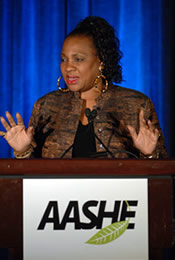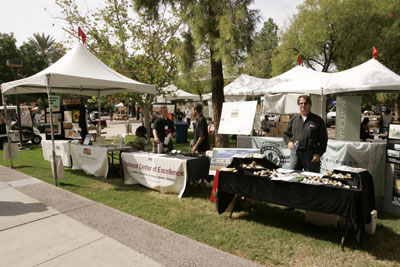The inaugural conference of the Association for the Advancement of Sustainability in Higher Education (AASHE) was held on the campus of Arizona State University in Tempe, AZ from October 4-6, 2006. With over 650 registered participants, the conference was the largest campus sustainability gathering to date in North America.
 AASHE 2006 attracted attendees from all facets of the higher education realm including sustainability leadership and coordinators from numerous institutions, senior administrators, facilities personnel, design consultants, faculty and students (one fifth of the attendees were students). The diversity of institutions and sustainability interests represented was impressive.
AASHE 2006 attracted attendees from all facets of the higher education realm including sustainability leadership and coordinators from numerous institutions, senior administrators, facilities personnel, design consultants, faculty and students (one fifth of the attendees were students). The diversity of institutions and sustainability interests represented was impressive.
The conference was filled with educational opportunities addressed in over 200 concurrent sessions and panel discussions. They focused on every aspect of relevance and concern to the campus community, from global warming, renewable energy, sustainability curriculum, sustainable practices in campus dining, recycling, sustainable campus development, and green architecture, to name only a few. Poster presentations and an expo of sustainable products and service providers added to the offerings.
To the design professionals working for higher-ed institutions, in my opinion, several of the sessions were cutting edge. A recent master planning effort for Pacific Lutheran University analyzed its campus for inputs and outputs in an effort to actively seek resource conservation opportunities. The importance of an environmental master plan as a precursor to campus master plans was reinforced through examples from Emory University and The University of North Carolina at Chapel Hill. Also finding their way to the forefront, are post-occupancy assessments of LEED certified buildings for the efficacy of strategies implemented. Speakers also noted that the premium for green buildings was rapidly diminishing.

Sociologist Beverly Wright addresses the audience at AASHE 2006
(Courtesy AASHE)
Keynote addresses at the conference were both thought-provoking and inspiring. The first keynote address came from Bill McKibben, visiting scholar in environmental studies at Middlebury College. As a planner, Bill's address "hit the spot" to many planners in the audience when he emphasized the importance of good planning as the precursor to sustainable architecture. Interface, Inc. chairman Ray Anderson once again demonstrated that corporate profitability and sustainability can be spoken to in the same breath. Prominent sociologist and Beverly Wright's perspective on environmental justice concerns in Louisiana and her personal account of moving back to her neighborhood in New Orleans post-Katrina was emotionally charged and left a glimmer of hope for the future. In the concluding keynote address, Hunter Lovins, co-founder of the Rocky Mountain Institute and president of Natural Capitalism, Inc. mapped the road to a sustainable future through natural capitalism and fields like "biomimicry" in an inspirational and captivating talk.
Of the three days of the conference, several events come to the forefront for their immediate relevance to the present-day that may be of interest to the larger audience:
Global Warming Initiatives
In 2005, James Hansen (Director, NASA Goddard Institute for Space Studies) said that "We have to stabilize emissions of carbon dioxide within a decade, or temperatures will warm by more than one degree. That will be warmer than it has been for half a million years, and many things could become unstoppable."
A year later, Mr. Hansen's concern was a recurring theme at the conference. AASHE co-founder Tony Cortese reminded attendees that we now had only nine years left. To this end, AASHE 2006 offered the platform for promoting the recently started "Focus the Nation", a major educational initiative that aims to coordinate teams of faculty, students and staff at over a thousand colleges, universities and high schools in the United States, to collaboratively engage in a nationwide, interdisciplinary discussion centered around the theme of "Stabilizing the Climate in the 21st Century". This project will culminate on January 31, 2008, in the form of one-day, national symposia held simultaneously on campuses across the country.
Organized as a plenary session moderated by Julian Keniry of National Wildlife Federation, powerful appeals were made to join the Focus the Nation initiative as well as the Campus Climate Challenge (a student initiative). Billy Parish of the Energy Action Coalition and Brandon Armstrong of Tennessee Alumni & Students for Sustainable Campuses, represented student leadership voices from across the nation.
AASHE revealed its own initiative during the plenary -- the "American College and University Presidents Climate Commitment" (ACUPCC). ACUPCC's immediate goal will be to get over 100 presidents to sign a commitment by June 2007 that will ultimately lead to climate neutral campuses.
Campus Sustainability Leadership Awards
AASHE also presented its first annual Campus Sustainability Leadership Awards. The winners were the University of British Columbia, Berea College, Warren Wilson College, and Lane Community College. These awards recognize institutions that have demonstrated an outstanding overall commitment to sustainability in their governance, academics, operations, and community outreach.
The applications for these awards serve as excellent profiles of each campus's sustainability efforts and are available online at: www.aashe.org/resources/profiles/profiles.php
The awards are endorsed by the Higher Education Associations Sustainability Consortium (HEASC), a network of 13 leading higher education associations with a commitment to advancing sustainability within their constituencies as well as in the system of higher education.

ASU School of Sustainability
AASHE 2006 was also the venue for the announcement of the School of Sustainability at Arizona State University. One of the first of its kind, the program is currently accepting applications for Fall 2007. Speaking to those present, Chuck Redman, Director, Global Institute of Sustainability, ASU said they were looking to the campus sustainability movement to help shape the program to be relevant to real world needs.
As the main conference came to a close on Friday evening, it was just the beginning for over 50 students who stayed on through the next day for a day-long "Student Convergence" of young sustainability leadership. Stay tuned -- the results will be coming your way soon on a campus near you.
About AASHE
AASHE is an association of colleges and universities in the U.S. and Canada working to create a sustainable future. It was founded in 2006 with a mission to promote sustainability in all sectors of higher education -- from governance and operations to curriculum and outreach -- through education, communication, research and professional development. Its membership has quadrupled since its establishment. It now counts 150 campus members and is still growing rapidly. AASHE defines sustainability in an inclusive way, encompassing human and ecological health, social justice, secure livelihoods, and a better world for all generations.
For more information visit: www.aashe.org.
R. Umashankar focuses on sustainable planning and design for higher-ed institutions with Hughes Good O'Leary and Ryan, Inc. in Atlanta, Georgia.

Maui's Vacation Rental Debate Turns Ugly
Verbal attacks, misinformation campaigns and fistfights plague a high-stakes debate to convert thousands of vacation rentals into long-term housing.

Planetizen Federal Action Tracker
A weekly monitor of how Trump’s orders and actions are impacting planners and planning in America.

Chicago’s Ghost Rails
Just beneath the surface of the modern city lie the remnants of its expansive early 20th-century streetcar system.

Bend, Oregon Zoning Reforms Prioritize Small-Scale Housing
The city altered its zoning code to allow multi-family housing and eliminated parking mandates citywide.

Amtrak Cutting Jobs, Funding to High-Speed Rail
The agency plans to cut 10 percent of its workforce and has confirmed it will not fund new high-speed rail projects.

LA Denies Basic Services to Unhoused Residents
The city has repeatedly failed to respond to requests for trash pickup at encampment sites, and eliminated a program that provided mobile showers and toilets.
Urban Design for Planners 1: Software Tools
This six-course series explores essential urban design concepts using open source software and equips planners with the tools they need to participate fully in the urban design process.
Planning for Universal Design
Learn the tools for implementing Universal Design in planning regulations.
planning NEXT
Appalachian Highlands Housing Partners
Mpact (founded as Rail~Volution)
City of Camden Redevelopment Agency
City of Astoria
City of Portland
City of Laramie


























